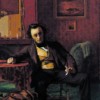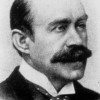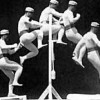
Linda M. Shires, “Color Theory—Charles Lock Eastlake’s 1840 Translation of Johann Wolfgang von Goethe’s Zur Farbenlehre (Theory of Colours)”
The nineteenth century witnessed major developments in color theory, pigment manufacturing, and painting techniques. In 1840, Charles Lock Eastlake—painter, art scholar, and collector—translated Goethe’s 1810 Zur Farbenlehre or Theory of Colours as a handbook and a history, with his own erudite notes, to aid British painters. The volume aimed to offer nineteenth-century artists a deeper education in color than Royal Academy training, which still emphasized imitation of old masters with instruction in composition and line. Eastlake also aimed to restore Goethe’s Aristotelian emphasis on the eye’s perception of color. A focus of debate among scientists and artists, the anti-Newtonian Theory of Colours seriously engaged painters as different in style as J. M. W. Turner and Holman Hunt, both of whom were fascinated by color and nature as seen by the eye. Moreover, Eastlake’s learned notes remained unrivaled for their detailed knowledge of Aristotelian natural science and optics, early technical treatises on painting, and specific Renaissance paintings. Charles Lock Eastlake, a growing authority in the art world of London, went on to be knighted (1850), elected President of the Royal Academy (1850), and appointed the first Director of the National Gallery of Art (1855).

Deborah Epstein Nord, “On Augustus Egg’s Triptych, May 1858”
These three paintings representing the decline of a family as the result of the wife’s presumed infidelity cannot be read in strictly linear fashion, as if they followed the narrative structure of serial fiction. Rather, a reading of the painting that takes into account the spatial and iconographic relationship between the three panels yields the complex and open-ended meaning of the triptych’s story.

Amy Woodson-Boulton, “The City Art Museum Movement and the Social Role of Art”
British art museums developed along substantially different lines than those in Continental Europe. Rather than create a centrally supported or designed system of cultural provision, the British Parliament passed permissive legislation in the middle of the nineteenth century that allowed localities to choose to establish public libraries and museums. Cities thus founded art museums independently, at the instigation of committed local reformers and benefactors, while most national institutions proceeded by Parliamentary acts rather than through the nationalization of royal collections. A generation later, inspired by the works of John Ruskin and the new aesthetic of Pre-Raphaelitism, many men (and some women) pushed their cities to create art museums not primarily as a means to educate the public about art history, but to counteract the toxic effects of the moral and physical ugliness of industrial capitalism, and of industrial cities in particular. The resulting institutions formed a new kind of domesticated public space, bringing together ideas about the middle-class home as a refuge and about beauty as a means of “improving” the working classes. However, John Ruskin himself often criticized these efforts as too accommodating of industrial society.

Rachel Teukolsky, “Walter Pater’s Renaissance (1873) and the British Aesthetic Movement”
Walter Pater’s Studies in the History of the Renaissance is known as the “golden book” of the British Aesthetic movement. Though ostensibly focused on Italian Renaissance art, the book speaks obliquely to Pater’s own Victorian moment, challenging conventional codes of religion, morality, sexuality, and scholarship. This essay surveys Pater’s diverse methods of quiet rebellion, including his ironic treatment of critical and scholarly norms. The essay’s second part considers the relation of The Renaissance to the emergence of popular aestheticism in the later 1870s.

Linda M. Shires, “On Color Theory, 1835: George Field’s Chromatography“
George Field’s Chromatography, or, A Treatise on Colours and Pigments, and of Their Powers in Painting, &c. (January 1835) examines the properties of pigments, relations among colors, and color as a symbolic and moral force. While the color theories of Chromatography dated quickly, this seminal book’s importance to a material history of color and oil painting remains undisputed.

Morna O’Neill, “On Walter Crane and the Aims of Decorative Art”
Walter Crane (1845-1915) was one of the most important, versatile, and radical artists of the nineteenth century: a painter, decorator, designer, book illustrator, poet, author, teacher, art theorist, and socialist. As a synthesis of art, design, and politics, Crane’s career offers new insights into the tradition of painting, the status of the decorative arts, and the transgression of their boundaries at the end of the nineteenth century. His work provides an important, decorative alternative to a realist idiom for socialist art.

Margaretta S. Frederick, “On Frederic Shields’ Chapel of the Ascension, 1887-1910”
On 26 February 1911, the Pre-Raphaelite artist Frederic Shields (born 1833) died, having spent the last twenty years of his life devoted to the decoration of the Chapel of the Ascension in Bayswater, London. Conceived of in 1887, completed in 1910, bombed in 1944 during the Blitz of World War II and demolished in 1969, the Chapel represents changing Victorian precepts of religion and faith as well as attitudes towards public art and decoration on the eve of the modern age. Designed by the architect and aesthete Herbert Horne (1864-¬1916) and modeled on thirteenth-century northern Italian church architecture, the chapel design was a reflection of the British rediscovery of the Italian Renaissance during the Victorian period. Shields’ use of the marouflage technique, mimicking continental fresco schemes, reflects a national desire to raise public British art to a level of “high art,” which would ensure it a place in the art historical canon.

Nicholas Frankel, “On the Whistler-Ruskin Trial, 1878”
In 1877 the painter James McNeill Whistler initiated an action for libel against the critic John Ruskin, who had defamed Whistler and his paintings in print. The legal outcome of the resulting trial—a technical verdict for Whistler, but with damages of just one farthing and no award of costs—satisfied nobody and represents a turning point in the principal antagonists’ lives. As importantly, it heralded a reconfiguration in the respective positions of the critic and the artist, if not a reconceptualization of the very meaning of these terms. The trial exposed to scrutiny the spiritualizing mission of criticism itself while bringing about an elevation and expansion of the concept of the artist. As Shearer West has argued, it also offered an important precedent for the power of laughter and wit to demolish the self-representations of established power.

Pamela Fletcher, “On the Rise of the Commercial Art Gallery in London”
The modern commercial art gallery emerged as a distinct institutional form in the middle years of the nineteenth century, profoundly changing the physical, economic and social relationships between artists, dealers, art objects, and viewers.

Garrett Stewart, “Curtain Up on Victorian Popular Cinema; Or, The Critical Theater of the Animatograph”
Hard on the heels of the Lumière “Cinématographe” in its Paris debut, the West End appearance of its most successful British equivalent, Robert W. Paul’s “Animatograph,” brought the apparatus for moving-image projection before a British public that would soon flock to its display of miscellaneous short films in theatrical venues all across England, propelling a widespread Victorian fascination with the new medium of visual spectacle and eventual (edited) storytelling, the latter in narrative formats by turns comic, melodramatic, and fantastic. In these emergent genre bearings alone, here was an entertainment technology that looked back into the earlier Victorian period as well as forward to both popular and experimental modernism. Much recent commentary has aimed at connecting this next-century destiny not just to the medium’s Victorian technological origins but to cultural orientations—and literary prototypes—in nineteenth-century habits of attention and imagination.
